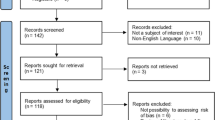Abstract
The aim of the study was to ascertain the validity of a personal protocol used for the diagnostic classification of a group of 20 patients suffering from migraine without aura and with recurrent vertigo and postural disorders. A series of ten factors (anamnestic and constitutional) considered predictive of migrainous vertigo and four types of response to sensory provocation made it possible to identify two types of patients: type A, simultaneous presence of at least 5 (≥50%) of the 10 factors considered and at least 2 (≥50%) of the four established responses; type B, presence of fewer than five factors (≤50%), or of more than five (≥50%) but fewer than two (≤50%) of the responses envisaged by the protocol. All patients underwent migraine prophylaxis for 4 months. Vertigo and postural status were evaluated using a questionnaire, i.e. the Dizziness Handicap Inventory (DHI), and a posturographic test before and after prophylaxis. The treatment was considered effective by 30% of the total group of 20 patients and by 75% of type A patients. No improvement was recorded in type B patients. Furthermore, the latter group did not show significant changes in the DHI or posturographic tests. Instead, type A patients demonstrated a statistically significant reduction in sway area and DHI score at the end of prophylaxis (P = 0.001). Research into a particular constitutional functional habitus, thus, proved useful for the diagnostic definition of migraine-associated vertigo.

Similar content being viewed by others
References
Kuritzky A, Ziegler DK, Hassanein R (1981) Vertigo, motion sickness and migraine. Headache 21:227–231
Kuritzky A, Toglia JU, Thomas D (1981) Vestibular function in migraine. Headache 21:110–120
Kayan A, Hood JD (1984) Neuro-otological manifestations of migraine. Brain 107:1123–1142
Dieterich M, Brandt T (1999) Episodic vertigo related to migraine (90 cases): vestibular migraine? J Neurol 246:883–892
Neuhauser H, Leopold M, Von Bevern M (2001) The interrelations of migraine, vertigo and migrainous vertigo. Neurology 56:436–441
Pagnini P, Verrecchia L, Giannoni B, Vannucchi P (2003) La Vertigine Emicranica. Acta Otorhinolaryngol Ital Suppl 75:19–27
Verrecchia L, Giannoni B, Vannucchi P, Pagnini P (2008) Vertigine emicranica. In: Cortesina G, Albera R (eds) Trattato di Vestibologia (volume 3), vol 35, pp 235–260
Headache Classification Subcommittee of the International Headache Society (2004) The international classification of headache disorders, 2nd edn. Cephalalgia 24(Suppl 1):1–160
Jacobson GP, Newman CW (1990) The development of the Dizziness Handicap Inventory. Arch Otolaryngol Head Neck Surg 116:424–427
Jongkees LB (1964) Electronystagmography. HNO 12:325–329
Nuti D, Gufoni M, Salerni L (2008) Le prove termiche. In: Cortesina G, Albera R (eds) Trattato di Vestibologia (volume 2). vol 7, pp 71–86
Dumas G, Perrin P, Schmerber S (2008) Nystagmus induced by high frequency vibrations of the skull in total unilateral peripheral vestibular lesions. Acta Otolaryngol 128(3):255–262
Nuti D, Mandalà M (2005) Sensitivity and specificità of mastoid vibration test in detection of effects of vestibular neuritis. Acta Otorhinolaryngol Ital 25(5):271–276
Bohmer A, Rickenmann J (1995) The subjective visual vertical as a clinical parameter of vestibular function in peripheral vestibular diseases. J Ves Res 5:35–45
Association Française de Posturologie (1986) Normes 1985. AFP Edit, Paris
Mac Donald BK, Cockerel OC, Sander JW, Shorvon SD (2000) The incidence and lifetime prevalence of neurological disorders in a prospective community-based study in the UK. Brain 123:665–676
Baloh RW (1997) Neurotology of migraine. Headache 37:615–621
Reploeg MD, Goebel JA (2002) Migraine-associated dizziness: patient characteristics and management options. Otol Neurotol 23:364–371
Lipton RB, Dodick D, Kolodner K, Endicott J, Hettiarachchi J, Harrison W (2003) A self-administered screener for migraine in primary care. The ID Migraine TM validation study. Neurotology 61:375–382
Hincliffe R (1967) Headache and Meniere’s disease. Acta Otolaryngol 63:384–390
Rassakh CH, Harker LA (1992) The prevalence of migraine in Meniere’s disease. Laryngoscope 102:135–138
Atkinson M (1962) Migraine and Meniere’s disease. Arch Otolaryngol 75:48–51
Drummond PD (2002) Motion sickness and migraine: optokinetic stimulation increases scalp tenderness, pain sensitivity in the fingers and photophobia. Cephalalgia 22:117–124
Rossi et al (2005) Balance disorders in headache patients: evaluation by computerized static stabilometry. Acta Neurol Scand 111(6):407–413
Author information
Authors and Affiliations
Corresponding author
Rights and permissions
About this article
Cite this article
Faralli, M., Longari, F., Crognoletti, M. et al. Anamnestic factors and functional aspects in the selection of patients with migrainous vertigo. Eur Arch Otorhinolaryngol 267, 1157–1162 (2010). https://doi.org/10.1007/s00405-009-1164-8
Received:
Accepted:
Published:
Issue Date:
DOI: https://doi.org/10.1007/s00405-009-1164-8




